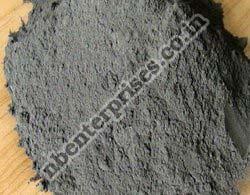-
nbenterprises2002@gmail.com -
View Mobile Number
Osmium Powder
Contact Us
N.B. Enterprises
Tikrapara Road, Tikrapara, Bilaspur, Chhattisgarh - 495004, India
Call Us : View Mobile Number
One of the platinum group metals, osmium is bluish-white, lustrous, extremely hard and brittle. Its properties make it ideal for combining with other platinum metals to produce very hard alloys. Osmium has the highest melting point and lowest vapor pressure of the platinum group and it is very difficult to fabricate. While osmium powder or sponge is affected by air at room temperature, the metal is relatively inert in ambient conditions.
Osmium (Os) Typical Applications:
- Because of the volatility and extreme toxicity of its oxide, osmium is rarely used in its pure state, and is instead often alloyed with other metals that are used in high-wear applications. Osmium alloys such as osmiridium are very hard and, along with other platinum group metals, is almost entirely used in alloys employed in the tips of fountain pens, instrument pivots, and electrical contacts, as they can resist wear from frequent use. The stylus (needle) in early phonograph designs was also made of osmium, especially for 78-rpm phonograph recordings, until industrial diamond replaced the metal in later designs.
- Osmium tetroxide has been used in fingerprint detection and in staining fatty tissue for microscope slides. As a strong oxidant, it cross-links lipids mainly by reacting with unsaturated carbon-carbon bonds, and thereby both fixes biological membranes in place in tissue samples and simultaneously stains them, since osmium atoms are extremely electron dense, making OsO4 an important stain for transmission electron microscopy (TEM) studies of many biological materials. An alloy of 90% platinum and 10% osmium (90/10) is used in surgical implants such as pacemakers and replacement pulmonary valves.
- The tetroxide (and a related compound, potassium osmate) are important oxidants for chemical synthesis, despite being very poisonous.
- In 1898 an Austrian chemist, Auer von Welsbach, developed the Oslamp with a filament made of osmium, which he introduced commercially in 1902. After only a few years, osmium was replaced by the more stable metal tungsten (originally known as wolfram). Tungsten has the highest melting point of any metal, and using it in light bulbs increases the luminous efficacy and life of incandescent lamps.
- The light bulb manufacturer OSRAM (founded in 1906 when three German companies; Auer-Gesellschaft, AEG and Siemens & Halske combined their lamp production facilities), derived its name from the elements of OSmium and wolfRAM.
- Like palladium, powdered osmium will densely absorb hydrogen atoms, perhaps making it a potential candidate as a metal hydride battery electrode substance, but it will react with potassium hydroxide, the most common battery electrolyte.

